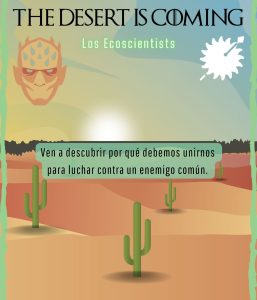Climate Detectives Projects 2022-2023
Project title: The desert is coming
Team: The ecoscientist
CEIP Nuestra Señora de Monteagud Uleila del Campo Spain 8 Student’s age: 12-13 years old
If you look out of the window, which environmental problem can you detect with the naked eye?
Si miras por la ventana ¿Qué problema mediambiental puedes detectar a simple vista?

In our research project we have analysed the consequences of climate change, specifically desertification, which is one of the consequences that most affects the environment in which we find ourselves. After finding out how desertification affects us, we have reviewed the proposals of different organisations to halt its advance. To do this, we have made a weather station with an arduino to monitor daily weather data from our town, and we have created a vermicomposter to create worm humus with the organic waste generated in our homes and at school. Finally, we have applied this worm humus in the creation of our school garden to check how this product favours the growth of plants compared to the soil we find in our locality.
En nuestro proyecto de investigación hemos analizado las consecuencias del cambio climático, concretamente, la desertificación, que es una de las consecuencias que más afecta al entorno en el que nos encontramos. Tras informarnos de como nos afecta la desertificación, hemos revisado las propuestas de diferentes organismos para frenar su avance. Para ello, hemos realizado realizado una estación meteorológica con arduino para monitorizar diariamente los datos climáticos de nuestra localidad, y hemos creado una vermicompostera para crear humus de lombriz con los residuos orgánicos que se generaban en nuestros hogares y en el colegio. Por último, hemos aplicado este humus de lombriz en la creación de nuestro huerto escolar para comprobar como este producto favorece el crecimiento de plantas en comparación con el suelo que nos encontramos en nuestra localidad.

After reviewing the literature, we can see that climate change is leading to desertification in our country. The data analysed show that rainfall patterns are increasingly insufficient. 28 mm in 4 months are insufficient for the consumption and needs of today’s society. In addition, we can see that the temperature is also unusually high for the winter months in which we were at the time of recording the climate data for our locality. How can we make the most of this scarce rainfall and avoid the evaporation of water from the soil? Through regenerative agriculture that makes it possible to build living soils in which it is possible for vegetation to grow, which is essential for attracting and provoking rainfall as set out in the theory of the biotic pump.
Tras la revisión de la literatura podemos evidenciar que en nuestro país el cambio climático nos está llevando a la desertificación. Los datos analizados muestran unos regímenes de lluvia cada vez más insuficientes. 28 mm en 4 meses resultan insuficientes para los consumos y necesidades de la sociedad actual. Además, podemos ver como la temperatura es a su vez inusualmente alta para los meses de invierno en los que nos encontrábamos al momento de registrar los datos climáticos de nuestra localidad. ¿Cómo podemos aprovechar al máximo estas precipitaciones escasas y evitar la evaporación del agua del suelo? a través de la agricultura regenerativa que posibilite la construcción de suelos vivos en los que sea posible el crecimiento de la vegetación, la cual resulta fundamental para atraer y provocar lluvias tal y como se expone en la teoría de la bomba biótica.
In our research project we have analysed the Sahara Green Ring proposal to slow down the advance of the desert. In our environment, the soil we can find is worn out. Therefore, we must first apply regenerative agriculture to make the soil fertile again and be able to cultivate plants that favour the retention of humidity in the environment, provide shade to prevent the evaporation of water from the soil and lower temperatures. How can we achieve this regeneration of the soil prior to the reforestation of the environment? Through earthworm humus.
We have analysed its properties and have been able to prove that it is the most powerful organic and natural fertiliser that can be used. In our town there is a very important cattle industry. From this industry, we can obtain a by-product such as manure and use it as food for the California red earthworms that we have introduced in our lumbricarium to obtain a new product (earthworm humus), applying the bases of the circular economy.
This humus will be applied to the soil of our town to provide it with the necessary nutrients for its regeneration. After this regeneration, reforestation of the mountain ranges surrounding the Tabernas desert will begin in order to slow down its expansion, lower the temperatures of the environment and increase the rainfall regimes as stated in the theory of the biotic pump.
En nuestra proyecto de investigación hemos analizado la propuesta del anillo verde del Sahara para frenar el avance del desierto. En nuestro entorno, el suelo que podemos encontrar es un suelo desgastado. Por ello, previamente debemos aplicar la agricultura regenerativa para hacer que el suelo vuelva a ser fértil y poder cultivar plantas que favorezcan la retención de la humedad del entorno, aporten sombras para evitar la evaporación del agua del suelo y bajen las temperaturas. ¿Cómo podemos conseguir esa regeneración del suelo previa a la reforestación del entorno? A través del humus de lombriz.
Hemos analizado sus propiedades y hemos podido evidenciar que es el abono orgánico y natural más potente que se puede utilizar. En nuestra localidad existe una industria ganadera bovina muy importante. De esta industria, podemos obtener un subproducto como es el estiércol y utilizarlo como alimento para las lombrices rojas de california que hemos introducido en nuestro lumbricario para obtener un nuevo producto (humus de lombriz), aplicando las bases de la economía circular.
Este humus será aplicado al suelo de nuestra localidad para dotarlo de los nutrientes necesarios para su regeneración. Después de esta regeneración se comenzarán a reforestar las sierras que rodean al desierto de Tabernas para frenar su expansión, bajar las temperaturas del entorno y aumentar los regímenes de lluvia tal y como se expone en la teoría de la bomba biótica.
https://drive.google.com/file/d/1_B1nlqf2kRFTnw7rNMQvJgVTyL47AGS1/view?usp=share_link
This project was automatically translated into English.
Projects are created by the teams and they take the full responsibility of the shared data.
← All projects




